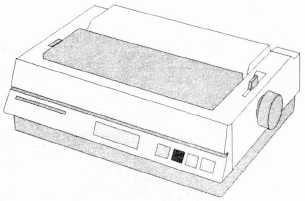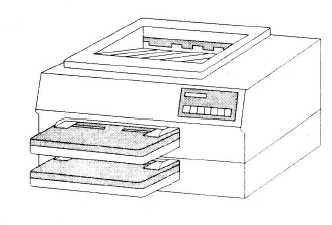form of drawing media. When you have finished
producing the drawing on CAD, you will order the
computer to send the information to the plotter, which
will then reproduce the drawing from the computer
screen. A line-type digital plotter is an electro-
mechanical graphics output device capable of two-
dimensional movement between a pen and drawing
media. Because of the digital movement, a plotter is
considered a vector device.
You will usually use ink pens in the plotter to
produce a permanent copy of a drawing. Some
common types are wet ink, felt tip, or liquid ball, and
they may be single or multiple colors. These pens will
draw on various types of media such as vellum and
Mylar. The drawings are high quality, uniform,
precise, and expensive. There are faster, lower quality
output devices such as the printers discussed in the
next section, but most CAD drawings are produced on
a plotter.
The Printer
A printer is a computer output device that
duplicates the screen display quickly and
conveniently. Speed is the primary advantage; it is
much faster than plotting. You can copy complex
graphic screen displays that include any combination
of graphic and nongraphic (text and characters)
symbols. The copy, however, does not approach the
level of quality produced by the pen plotter. Therefore,
it is used primarily to check prints rather than to make
a final copy. It is, for example, very useful for a quick
preview at various intermediate steps of a design
project.
The two types of printers in common use are dot
matrix (fig. 2-17) and laser (fig. 2-18). The laser
printer offers the better quality and is generally more
expensive.
COMPUTER-AIDED
DESIGN/COMPUTER-AIDED
MANUFACTURING
2-10
You read earlier in this chapter how we use
computer technology to make blueprints. Now you’ll
learn how a machinist uses computer graphics to lay
out the geometry of a part, and how a computer on the
machine uses the design to guide the machine as it
makes the part. But first we will give you a brief
overview of numerical control (NC) in the field of
machining.
Figure 2-17.—Dot matrix printer.
Figure 2-18.—Laser jet printer.
NC is the process by which machines are
controlled by input media to produce machined parts.
The most common input media used in the past were
magnetic tape, punched cards, and punched tape.
Today, most of the new machines, including all of
those at Navy intermediate maintenance activities, are
controlled by computers and known as computer
numerical control (CNC) systems. Figure 2-19 shows
a CNC programming station where a machinist
programs a machine to do a given job.
NC machines have many advantages. The greatest
is the unerring and rapid positioning movements that
are possible. An NC machine does not stop at the end
of a cut to plan its next move. It does not get tired and
it is capable of uninterrupted machining, error free,
hour after hour. In the past, NC machines were used
for mass production because small orders were too
costly. But CNC allows a qualified machinist to
program and produce a single part economically.




